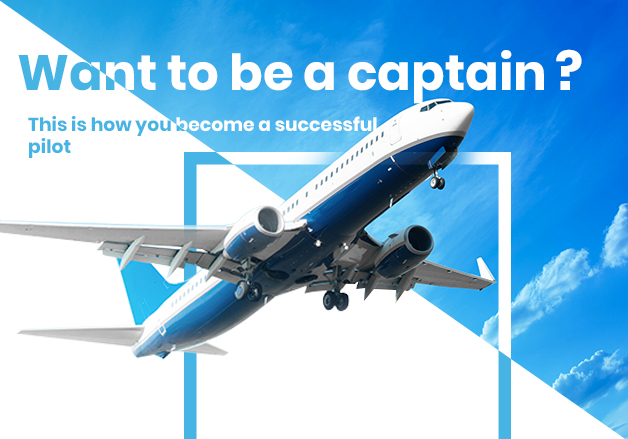

Becoming a pilot is one thing and becoming a successful captain pilot is another thing entirely. Some people study for a few years, earn their pilot license and never become captains. While other people move up in their careers quite quickly and become successful pilots and captains within six to seven years.
Where does the difference come from?
It actually depends on several factors, only one of them is having passion for the job, so even if you happen to be passionate about the career you have to take the right steps to achieve all that you can achieve in it.
Here is how you become a successful captain pilot.
The first step, become a pilot

To become a pilot you first have to research flight training options. Start by comparing available programs then choose the best one.
To apply for a professional pilot license you need to meet some basic medical requirements to fly. That’s why you should apply for a first-class medical certificate through an Aeromedical Examiner (AME). If you don’t know where you can get one do not fret, the aviation school of your choice will provide you with this information. You also need to be at least 17 years old and speak fluent English, as most of the subjects you are going to study are in English.
Once you have successfully enrolled, you will need to complete some ground training as well as flight training. Ground training usually covers topics like aerodynamics, radio communication protocols, and navigation using visual flight rules (VFR). The duration of the ground training course differs from one learning institution to another, but it usually takes around a year to complete the course, especially in non-English speaking countries where the students have to study English as well as other subjects.
After this ground training, you should be ready to take the knowledge exam and pass with a grade of at least 70%.
Some academies now allow programs where students can work on both simultaneously, ground training and flight training. To get your license you need to complete the required 150 flight training hours, this often takes from one to two years.
After you have successfully completed your training, you shall be ready to take the practical exam to get your commercial pilot license. This exam includes an oral part and a practical part.
Got your license? Congratulations, now you are a pilot.
The second step, find a job as a co-pilot

In addition to the license, commercial pilots need an Instrument Rating and a Multi-Engine Rating to carry paying passengers. These licenses require additional training that covers rules and procedures specific to instrument flying, and flight training by reference to certain instruments and specific aircraft.
The tests comprise a written exam and a practical test, known as the check ride, all check rides are divided into an oral part and an actual flight.
However, many pilots complete the required training hours to apply for these exams by working as co-pilots.
When you acquire a commercial pilot license you can apply for a job in an airline and sit through an interview.
Keep in mind though that most major airlines require a lot of flying hours, that is why many pilots start their careers by applying for jobs at low-cost airlines until they gain enough experience that would allow them to apply in legacy carriers.
Interviews for pilot positions often reflect license exams, there are often check-rides in addition to a written test and an interview, especially for new pilots. In addition to that, airlines frequently conduct psychological tests to make sure that their pilots are qualified to make good decisions under pressure.
Did you pass the interview? Congratulations, you are officially a pilot!
The third step, get promoted

When you start your journey as a pilot, you probably get a job as a first officer (co-pilot), so how do you become a captain?
The process takes a long time, from 6 to 15 years, depending on the airline and the pilot’s skills and qualifications.
Pilots are only considered for promotion to become captains after they have logged at least 1,500 flight hours, and only if they hold a full Air Transport Pilots Licence (ATPL). This is the minimum requirement, other factors, however, are taken into consideration.
But before we start with the other factors it is noteworthy to mention that most legacy airlines, in fact, require a minimum of 3000 flight hours for their pilots to be promoted into captains.
Nonetheless, the experience does not grant the promotion, Meeting the flight hours requirement is only the start. If a pilot holds the required certificate and has logged in the required flight hours, the airline then looks into their training record and performance before starting a ‘command assessment’ that includes an interview and a simulator check.
This simulator check is a practical test in which the pilot is usually given a scenario with various malfunctions. It is designed to assess flight management skills and decision-making process.
After passing this assessment, the pilot starts a command course, which is the most demanding step, and where many pilots get stuck as the course is neither short nor easy to pass.
Did you pass the course? Congratulations, you are now a captain pilot!
The fourth step, become a successful captain pilot

Now that you have reached your goal and became a captain pilot, how do you become the best captain pilot you can be? How do you really become a successful pilot and have the bright future you aspire after?
There are certain qualifications and skills that successful captains possess, skills that allow them to be accomplished leaders.
They appreciate teamwork
Yes, the captain is the commander of the aircraft, he is the leader who takes the decisions and shoulders the responsibility. But in order to become a successful leader, you have to value teamwork. You have to know that you need every team member to do their job well so you can do your job well.
They take responsibility
Successful pilots do not blame others, they know very well that they are in charge, they are in control. To become a captain you have to know that with great power comes great responsibility. You are responsible for the aircraft and everyone on board. If a mistake happens, you have to be willing to work on it and find a way to correct it, not blame whoever did it.
They know the right balance
A leader who does not listen to others is a dictator, a leader who needs everyone’s approval is a pushover, a successful leader is someone who knows the right balance. To become a successful captain, you have to know how to take charge, and also how to listen to your team, this is called Crew Resource Management or CRM.
They are willing to acquire new skills
Many people wonder if leadership is by nature or nurture, and the answer is that is is a mixture of both. People are born with potential, and when they work on it and learn and grow and improve they achieve their full potential. In order to become a successful pilot, a person must have potential, but they must also be willing to work hard and learn new skills.
To learn more about becoming a pilot see also:
HOW TO BECOME A PILOT
References:
https://study.com/be_an_airline_pilot.html
https://www.thebalancecareers.com/how-to-become-an-airline-pilot-282888
https://www.osmaviationacademy.com/blog/essential-skills-for-pilots-leadership-and-teamwork
https://www.wikihow.com/Become-an-Airline-Pilot
https://pilotpatrick.com/moving-to-the-left-seat-captain-upgrade-part-1/
MORE ON


Why should you get a medical check before studying aviation?
Aviation TrainingQUESTIONS ABOUT OUR FLIGHT ACADEMY? ASK A TRAINING ADVISOR





